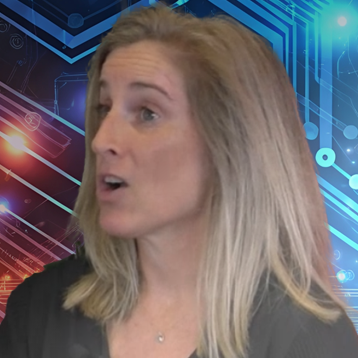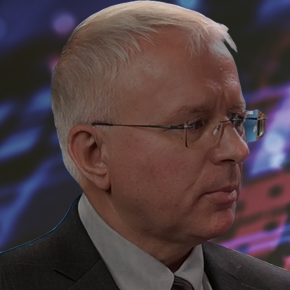May 25, 2022
Risk-Proof Your Supply Chain

Transcript
Leah Archibald: Sourcing and procurement specialists have had a rough couple of years at this point. First a global pandemic hit, and just when we were starting to climb out of shortages due to shutdowns, the Russian invasion of Ukraine and US trade wars with China further disrupted supply chains. Amidst the continuing pricing increases and material shortages, buyers have stopped asking the question: When will this end? And are instead asking a new question: How can we risk-proof our supply chain in a world that is filled with ever more and more risk?
My guest today is going to help us answer this question. Lily Thomas is an expert in supply chain management. She made her career in Sourcing and Procurement for the energy sector as a commodity manager at GE Oil and Gas, which merged with Baker Hughes. Lily Thomas weathered supply chain disruptions due to monsoons, political change and ever-present component shortages.
Today, she consults with companies on assessing risk in their supply chain, mitigating the cost of disruptions, and ultimately turning supply chain resiliency into a competitive advantage. Lily Thomas, welcome to the podcast.
Lily Thomas: Thank you. I’m very excited to be here.
Leah Archibald: We are excited to have you help us sort through the madness that is facing supply chains right now. So first, just give me a high-level view. What are you most stressed about in supply chain management? I mean, what do you worry about more: Is it COVID? Is it political instability? Is it material costs? Is it sanctions? What keeps you up at night?
Lily Thomas: When I was initially thinking about what it is out of all these things that keeps me up at night, I was thinking material costs. Because right now there’s not really an end in sight. It’s so dynamic – they’re changing all the time. And it’s tricky for buyers and commodity managers to get ahead of it, because just when you’ve agreed on pricing with the supplier and you think you’ve got a contract in place, the rates go up again, and you’re back to square one of having to negotiate again.
The only way you could really get a handle on it for the long term is you could do a spot buy. You could go and try to buy a lot of material right now: everything you’re going to need for the next year. But then what if the prices go down and you’re locked into the rate? That’s worrying. I guess you could try to create contracts to tie your pricing to a material index, but that’s a lot of work too.
Another issue that I think about is burnout of sourcing professionals. Just when you think you’ve solved one issue, another one comes up. I think many companies are trying to get more done in Sourcing and Procurement with less resources, and I worry about those resources just totally burning out too.
Leah Archibald: So, we want to get Sourcing professionals out of this high-stress environment. That’s why we’re talking about de-risking the supply chain. But my question is: where do you start? Later we’re going to talk long-term about de-risking the supply chain, but first of all let’s talk about what you do when you’re in an emergency situation. Let’s say a pandemic or a war just broke out. Or all of a sudden there are new sanctions. Do you start by identifying alternate sources for parts or materials? Do you start by consolidating your product line? Where do you start?
Lily Thomas: I think when you’re really in an emergency, the very first short-term step you have to take is prioritize which orders are important. You have to work with sales and product management to really look through what you can deliver and how. When we have scarce parts coming in, we are going to deliver on the orders that take priority at the expense of not delivering on others. That’s the first very short-term action.
Then you move on to trying to find alternatives for delivering on these other orders that aren’t top priority. Are there orders that could be fulfilled by a different product? You may have had orders for a product that’s scheduled to be obsoleted. Maybe it’s an old product – it’s not your current design anymore – but you’re still supporting it for a couple of customers who want that specific design. This may be the time you have to tell them: Look, you’re getting the new version. We can’t support the old version because the old version might require scarce parts. And it definitely requires the same valuable Engineering and Sourcing resources that are in short supply.
Leah Archibald: This really surprises me. I thought you were going to say first try to source it from a different location or try to very quickly ramp up a new supplier. But this is a different kind of negotiation strategy, i.e. just moving the customer to a different product. The product that you wanted, you’re not going to get – you’re going to get a newer version. That sounds very innovative.
Lily Thomas: And that’s not always an option. Because sometimes it is your newest version of the product that you can’t deliver. But sometimes switching one product for another could be faster than ramping up a new supplier. It depends on the complexity of the parts. Still, when you talk about trying to ramp up a new supplier and have them start from scratch, that can take a lot longer than saying to the customer: Hey, we have this other product sitting on the shelf that has a similar function that we could get to you.
Leah Archibald: What I’m hearing from you is that the role of a Sourcing Manager is much more strategic than I would have thought. You’re really looking at the whole product line of the business from a strategic point of view. You’re not only saying: How can we get the parts to make this? You’re also saying: How can we be prioritizing our production in a way that ultimately serves our customers best while serving serves the bottom line? There’s a lot to prioritize there: not just parts, but customers and value.
Lily Thomas: I think that’s definitely true. Which products are key to our strategy for the next five years? If we can’t deliver those products, it’s going to hurt us in ways other than just the bottom line – it’s going to hurt our growth overall.
When you talk about looking at values, some contracts have more severe liquidated damages in them, so the margin hit that you might take is something to consider. If you could find another source or if you could buy some inventory from a middle man, even if it’s going to be marked up and you’re going to take a margin hit, it might be way less expensive than the hit you would take if there are liquidated damages in the contract and you have to pay to the customer if you miss your delivery date.
There are a number of factors that you have to balance. At the end of the day, you probably aren’t going to get enough parts in the door to fulfill all the orders that you have. Definitely not on time to their due date, and maybe not at all. So, you have to look outside at other options besides just finding different sources for parts. Like I said, ramping up a new supplier can take longer than some of these other options.
Leah Archibald: Let’s say hypothetically that you get yourself out of this crisis mode and now you’re looking towards the future. How do you identify future potential problems in your supply chain?
Lily Thomas: It’s difficult because anything that you can do now would be preparing for what happened before. We don’t know what’s going to happen in the future. That’s one of the other things that keeps me up at night. We’re only learning from things that burned us in the past. But there are going to be new challenges that we couldn’t even think of. Most people wouldn’t have thought that a pandemic could cause all of these supply chain complexities.
Leah Archibald: It’s like the Black Swan hypothesis. How do you prepare for something that comes once in a century? How do you prepare for something that you haven’t seen before? Maybe the question isn’t: How do you prepare for what’s going to come in the future? But: How do you build a resilient supply chain or an agile supply chain?
Lily Thomas: I think it’s important to ask this question for each of your different parts. Because for some parts it easy to go and find another supplier, but for other parts it’s going to be really hard. So first you have to understand – for all of the thousands of parts that you’re buying – or when you’re at a company the size of GE the hundreds of thousands of parts across all of the different divisions – what are parts are straightforward that a number of different people could make, and what are the ones that are very complex for which it would be difficult and a lot more timely to find a different supplier. Some parts have tooling investments involved. If we wanted a new supplier, we’d have to also move the tooling to them or invest in new tooling. Also, what are the parts where we don’t own the intellectual property and the supplier owns it? Because then there’s no way you could find someone else unless you develop that technology yourself. That is how you can start making longer term plans.
Leah Archibald: So, for Sourcing professionals, it’s not only negotiation, it’s a knowledge of manufacturability – what does it take to create these components.
Lily Thomas: That’s a good point. Let’s say you have a supplier that can make this casting, and they’ve been making it for many years. Do you have an understanding of how difficult of a casting is it to make? Would it be something that a number of different suppliers could do? Or is there something particular about the supplier that enables them to do it? You definitely have to be aware of what it takes to make the part – to understand how difficult it would be to find other sources to make it.
Leah Archibald: And if they can do it, can they do it at scale? Can they do it at the volume that you need it? Can they do the casting and also punch the holes? Or do they have to run it through a machine with labor cost associated with it?
Lily Thomas: Right. Say our current supplier is plating it in-house. If we find other suppliers, can they also plate it in-house? Or would they have to find someone else to do the plating operation? And then in addition to understanding the complexity of the products and what it takes to make them, it’s also good to understand how these products are distributed. What are the products where you’ve only got a single supplier that can make them? For a long time there has been a big push to get dual sources, or multiple sources that can make a part. But now it’s also becoming important to find multiple regions that can make a part. Because having multiple suppliers in the same region is not really good enough. If you had two suppliers in the Ukraine region, then you’d be pretty much out of luck right now.
Leah Archibald: Many manufacturing organizations have multiple suppliers in China. China is a pretty big country, but if we have trade sanctions against China, that’s not going to do us much good. Or if we can’t get the containers from China – if there’s a shortage of shipping containers –
Lily Thomas: Right. So, you need not only multiple sources, but sources in different regions, so that if some event impacts one region, you can pivot to a different region. In the US we have wildfires going on. So, it’s not like having parts made in the US is going to magically make you resilient either.
Leah Archibald: What strategy should an organization put in place as a priority to de-risk their supply chain?
Lily Thomas: Companies are already experienced going through an annual review process where they examine their parts and determine how to hit their cost savings targets each year. We just have to add risk to cost savings as a critical factor. What does our risk look like for our different products? What are our critical components where we’ve only got one supplier or one region that can make it?
It’s probably a lot of work upfront to do that initial kind of classification: going through all the parts and figuring out how complex they are, what regions you’ve got them sourced from, and what suppliers you have qualified. But once you do it you can revisit that each year and create a project pipeline to de-risk those specific products. It’s really critical to build risk into your annual review and annual planning process. Then you and the Sourcing Specialist can come up with projects that help add resiliency.
Leah Archibald: If there’s no such thing as zero risk in supply chain, is it really possible to get buyers in Sourcing out of that emergency crisis management mode? Or is there always going to be this air traffic controller emergency stance that they’re in?
Lily Thomas: I think there’s always going to be some level of tactical work. We’ve got to expedite this order; we’ve got a quality issue on that order. There’s always going to be fires to put out. But I think what companies are also trying to do is automate tasks that are more repeatable. We could talk about automating purchase orders for spend that’s very consistent. Can you have the ERP system issue the purchase order instead of the buyer sitting down and issuing the purchase order each time? For quoting, can we have some sort of automated quoting process where you’ve agreed with the supplier on what their cost structure is, and you can basically predict what their cost would be for a part so you don’t have to do a laborious RFQ process?
I think companies are working on automating the repeatable tasks to free up resources to be more strategic. For example, material rates are going up. Could we free up some time for a buyer or a Commodity Manager by writing a contract with a critical supplier that ties their price to a material index? So they’re not having to constantly renegotiate pricing every time rates change?
There’s actually been research on this. McKinsey did a research study and found that companies that have collaborative supplier relationships tend to outperform their industry competitors by nearly two times. That’s a big deal. It’s more time investment upfront, but then it’s so much time savings later, because instead of just agreeing on a price for a part or a group of parts, you come to an agreement on the entire cost model. What is the labor structure like? What’s the overhead structure? What’s the capacity? What is the material index we are going to use? You agree on all of the underlying data points that go into the cost of a part, and then whenever you need them to make a part agreeing on the price take seconds.
You won’t be able to do it with each and every supplier, but when you can it will save you a lot of time down the line. And then you revisit those agreements annually. Although now with things like labor cost changing so fast, you might have to revisit it every six months now.
Leah Archibald: But either way, having that data, even having a fraction of that data upfront takes a lot of the ghost out of the machine.
Lily Thomas: Yes, definitely. And it can also help when you’re in some sort of supply chain emergency, if you’ve got a shortage or you’ve got a big spike in orders that you weren’t predicting or forecasting. If you have intimate knowledge of the supplier, then you can explain to product management or to sales: Look, this is going to be difficult for us for these reasons, because the supplier has this structure; they’ve got these orders and they have this many machines. It saves you this step of having to call up the supplier and get all the information from them in a crisis. If you know their factory like you know your own factory, it can help you assess how big of an issue some of those fluctuations will be.
Leah Archibald: One final question. If I pull back and look at supply chain management from a big picture perspective, Sourcing and Procurement specialists are really trying to answer two questions: 1) How to make it, and 2) Where to make it. From your experience in your role with GE and also from advising other companies on their supply chain, what is your biggest piece of advice for organizations approaching these questions?
Lily Thomas: I think you have to work with the whole product team: product management, engineering, and sales. You have to understand the targets and the goals for the end product. For this product, is cost the most important parameter to our customers? Is lead time the most important? What are the volume targets? Because all of those will really impact how to make it.
Knowing the different variables will also help you figure out where to make it. It has to be a cross-functional discussion, so that everyone’s on the same page of what’s most important for this product. Then each function can execute their piece of that.
Leah Archibald: You’ve given us a lot to think about today, not just for people who are in Sourcing and Procurement, but for the Executives, for the Product Managers, and for the Design Engineers. We all need to be thinking about this together as a team. Thank you so much for joining us on the podcast, it’s been a pleasure!
Lily Thomas: Thank you.







